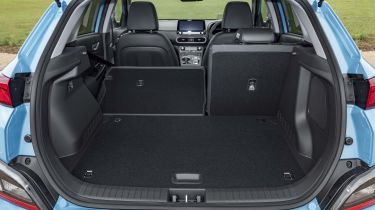Hyundai Kona Electric (2018-2023) review: boot space, seating & practicality
While the Hyundai Kona Electric is as roomy as the petrol and hybrid versions of the car, some other electric SUVs are a lot more versatile
| Length | Width | Height | Boot volume (seats up/down) |
|---|---|---|---|
| 4,180mm | 1,800mm | 1,570mm | 332 / 1,164 litres |
The Hyundai Kona isn't as compromised for space as some electric cars – thanks to its high-riding and relatively boxy body style – but there are plenty of rivals that better it for outright carrying capacity. That said, it should cope with the demands of daily family usage – both in terms of cabin storage and boot space. Its compact dimensions make it easy to drive around town, too.
Hyundai Kona Electric interior space, storage & comfort
The Kona’s interior has a light and airy feel and the lack of gearlever between the seats adds to the sense of spaciousness. Front-seat occupants are well looked-after, with comfortable chairs that offer a wide range of adjustment; in top-spec models they're both heated and cooled.
Even in the rear, the seats are reasonably roomy, and there’s certainly enough space for children or teenagers. Trying to cram a pair of six-footers in the back with tall front-seat occupants is a bit of an ask though, as knee and legroom will be tight. In other respects, the interior is practical, with roomy door bins and plenty of storage.
Boot space
The Kona Electric’s boot space is on a par with other compact electric SUVs including the Vauxhall Mokka Electric (310 litres) and Mazda MX-30 (366 litres). However, the MG ZS EV (470 litres) and Kia Niro EV (475 litres) trump the Hyundai in the practicality department.
You can drop the 60:40 split-folding rear bench in the Kona Electric, but the seats don’t fold completely flat, which further limits ultimate practicality. That said, with the seats dropped, luggage volume goes up to a roomy 1,164 litres.




